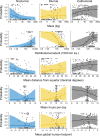When the wild things are: Defining mammalian diel activity and plasticity
- PMID: 40009684
- PMCID: PMC11864191
- DOI: 10.1126/sciadv.ado3843
When the wild things are: Defining mammalian diel activity and plasticity
Abstract
Circadian rhythms are a mechanism by which species adapt to environmental variability and fundamental to understanding species behavior. However, we lack data and a standardized framework to accurately assess and compare temporal activity for species during rapid ecological change. Through a global network representing 38 countries, we leveraged 8.9 million mammalian observations to create a library of 14,587 standardized diel activity estimates for 445 species. We found that less than half the species' estimates were in agreement with diel classifications from the reference literature and that species commonly used more than one diel classification. Species diel activity was highly plastic when exposed to anthropogenic change. Furthermore, body size and distributional extent were strongly associated with whether a species is diurnal or nocturnal. Our findings provide essential knowledge of species behavior in an era of rapid global change and suggest the need for a new, quantitative framework that defines diel activity logically and consistently while capturing species plasticity.
Figures







References
-
- Schmitz L., Motani R., Nocturnality in dinosaurs inferred from scleral ring and orbit morphology. Science 332, 705–708 (2011). - PubMed
-
- Anderson S. R., Wiens J. J., Out of the dark: 350 million years of conservatism and evolution in diel activity patterns in vertebrates. Evolution 71, 1944–1959 (2017). - PubMed
MeSH terms
LinkOut - more resources
Full Text Sources

